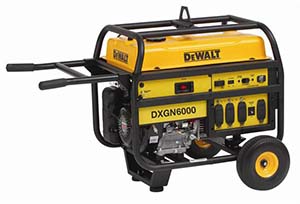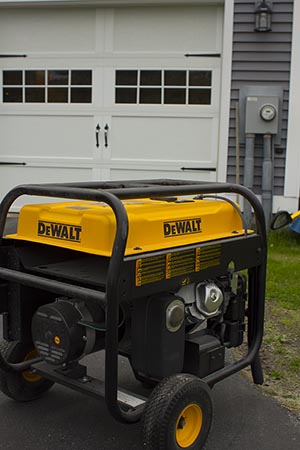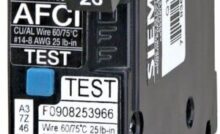Backup Generator Power – Be Prepared


Using Backup Generators
Each year hundreds of thousands of homeowners get left in the dark due to power outages caused by extreme weather. Whether it’s extreme wind, lightning, snow or ice the outages can last for days at times leaving no power for heat, water and refrigeration. One of the best solutions for power outages is having a reliable backup generator set up to power essential appliances in your home. In this article I’ll discuss how to use a backup generator in your home and precautions to follow.


Going out and buying a generator after the power goes out won’t really help out as there are some basic electrical changes that need to be done prior to “plugging” it in. In this article I’ll discuss some of those options so you can plan ahead before you need the generator to work! The key take away for you should be planning ahead and getting an electrician involved early in the project.
Backup Generator Power
In order to actually power basic essential appliances in your home you’ll need a portable generator and a generator transfer switch to connect the generator to your home. The generator transfer switch allows power from the generator to be fed into your electrical breaker panel and feed circuits in your house. The transfer switch also prevents power from the generator from being fed back out to the utility lines which would pose a serious risk to utility workers. Not only are transfer switches important for safety, they are required by law.
The transfer switch also protects your generator from power coming back into the home when the power is restored. The type of transfer switch that you use will depend on several factors which can be determined with your electrician. I highly recommend that this is a project for licensed electricians and definitely not a do-it-yourself project.
The transfer switch includes two major components; a sub-panel which typically sits next to your main electrical panel and a connection receptacle where you plug the generator into. It’s important to locate the receptacle in an area that’s easy to access and not too far from where you’ll run the generator so you can minimize the length the extension cord. From that point the electrician will run a heavy wire back to the sub-panel. Your electrician can help evaluate the location for the transfer switch.
The costs for installing a backup generator vary greatly depending on the size of the transfer switch, location, and complexity of running the wiring. Costs can range from as little as $500 up to $1,500 or more. I suggest you also have your electrician build a proper extension cord to go with the generator that will reach a safe location to run it and large enough to safely carry the rated current.
Generator Safety
Probably the most important topic with regard to backup generators is safety. Backup generators can be very dangerous if not operated according to the manufacturers recommendations and basic safety principles. Generator safety includes:
- Always run the generator according to the manufacturers specifications. Of particular concern is making sure the generator is not overloaded and it’s properly wired to your home.
- NEVER run a generator inside your home, garage or basement as this poses a significant risk of carbon monoxide poisoning.
- Be sure to run the generator a safe distance from doors and windows in order to avoid carbon monoxide.
- NEVER re-fuel a generator when it’s running as this poses a serious fire danger. You may be tempted to keep it running so that power isn’t disrupted to your home but he risk of a fire and serious injury are too great. Gas can spill causing a fire, vapor from the tank can catch fire, and sparks from the exhaust can catch fire.
- Be sure to do regular maintenance on your generator including starting it on occasion, changing oil, and keeping it full of fresh gas.
- Always use an extension cord that’s rated for the length and current produced by the generator.
- NEVER connect a generator to your home without a proper transfer switch.
Selecting A Generator
Selecting a generator can be as confusing as buying most home appliances with tons of choices and price points. Again, I highly recommend you work with an electrician when making this decision. First you’ll need to know how many circuits in your home you want to run, from that the electrician can tell you what size generator you need.
You can use a backup generator like I do which means you’ll have to wheel it outside, start it up, hook up the extension cord and throw the transfer switch. This is the least expensive option and the most practical. If you want an easier, more powerful solution you can upgrade to a standby generator that sits outside and automatically turns on when the power goes out. These are typically run on natural gas or propane and cost 2 to 5 times a much as a backup generator.
If you plan on buying a small backup generator I highly recommend buying a generator with an automatic throttle control and a good, smooth running engine. I really like Honda motors as they tend to be much quieter, smoother, and longer lasting. For my home I use a DEWALT DXGN6000 6,000 watt gas generator with a Honda motor. A smooth running engine will produce much “cleaner” power which is very important with all the sophisticated electronics in our homes today.
Be Prepared for Power Outages
The lesson here is to be prepared for power outages. Before you get left out in the cold take some time and find a decent backup generator for your home. Contact a local electrician and get a generator transfer switch installed so you can power your home in the event of a long term power outage.
Recent Posts
Framing Stick Nailer vs Coil Nailer
Which is Better a Stick Nailer or Coil Nailer? Framers have many choices in nailers…
How Many Roofing Nails Per Square of Shingles
Estimating How Many Nails for a New Roof When it comes to estimating materials for…
Composite / PVC Decking – Layout Tips & Advice
Composite / PVC Decking Layout Tips and Advice Composite and PVC decking have really changed…
Benefits of an ERV System (Energy Recovery Ventilator)
Benefits of ERV Systems (Energy Recovery Ventilator) If you're building a new home or doing…
Vermiculite Attic Insulation Abatement
Vermiculite Attic Insulation If your home was built before 1990 there is a chance it…
Nuisance Tripping of AFCI (Arc Fault) Circuit Breakers
Arc Fault (AFCI) Circuit Breakers Tripping Often An arc-fault circuit interrupter (AFCI) or arc-fault detection…
